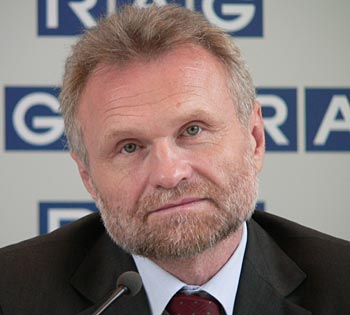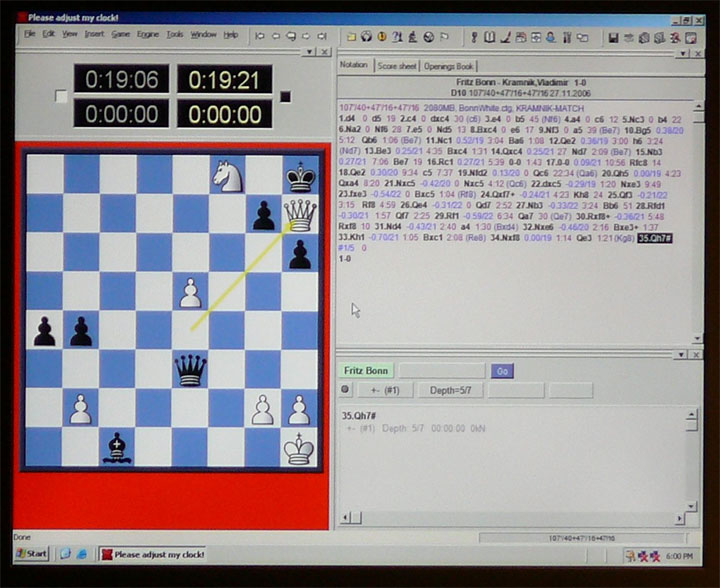.jpeg)

.jpeg)
In the previous birthday articles I described how:
Before we launch on today's narrative I'd like to try a little experiment – especially with readers who do not know or have forgotten what happened fifteen years ago. Come on, there are full grandmasters who were not born at the time.
Black, who is trying to win, has just played 34...Qa7-e3, offering to trade queens. It is your task is to decide if White (to play) can defend the position. After 35.Qxe3 Bxe3 will he be able to stop the black queenside pawns from promoting? Or is there some other defensive counterplay? For example, can he reach a draw with 35.Ng6+ Kh7 36.Nf8+ Kg8 37.Qd5+ Kxf8 38.Qd6+ Kf7 39.Qxb4? You can move the pieces on the board to try different lines. Please make a note of your assessment of the above position, and then read on...
After his 2002 match against Fritz in Bahrain World Champion Vladimir Kramnik, in 2004, played a 14-game Classical World Chess Championship against challenger Péter Lékó, and then in 2006, a reunification World Championship match against the FIDE Champion Veselin Topalov. He won both and retained his title. He was the uncontested World Champion. It was time to play Fritz again.
 The initiator and organiser of the match was Josef Resch (picture), a successful businessman from Mukachevo in Western Ukraine, and a friend of Kramnik. Resch was a passionate chess lover, whose company, Universal Event Promotion, a few years later, was bidding for the organisation of the FIDE 2010-2011 World Championship cycle, with a four million Euro budget (in the end negotiations with FIDE broke down).
The initiator and organiser of the match was Josef Resch (picture), a successful businessman from Mukachevo in Western Ukraine, and a friend of Kramnik. Resch was a passionate chess lover, whose company, Universal Event Promotion, a few years later, was bidding for the organisation of the FIDE 2010-2011 World Championship cycle, with a four million Euro budget (in the end negotiations with FIDE broke down).
Resch used his money to create a chess school for children in Ukraine, and financed matches with leading players, organizing tournaments in Moscow.
The prize fund for the match Kramnik vs Deep Fritz was set at one million dollars, specifically: Kramnik received a starting fee of 500,000 US-Dollar, which would be doubled if he defeated the computer in a six-round duel.
 The giant energy concern RAG was the sponsor, coming in as a new and important player in chess promotion. German Finance Minister Peer Steinbrück, arguably the world's strongest chess playing politician, spoke at the press conference before the event. A year earlier he had played an exhibition game against Kramnik.
The giant energy concern RAG was the sponsor, coming in as a new and important player in chess promotion. German Finance Minister Peer Steinbrück, arguably the world's strongest chess playing politician, spoke at the press conference before the event. A year earlier he had played an exhibition game against Kramnik.
Steinbrück said he saw the match between Kramnik and Fritz as a cultural battle between outstanding representatives of human and technical intelligence.
The event was staged in the Art and Exhibition Hall in Bonn, Germany.
Of course the program Deep Fritz had, in the four years since Bahrain, become better and faster. Kramnik said his opponent was definitely the favourite in this encounter, and rated his chances for beating the machine at about 40-50%. “At any rate my chances against the computer are higher than 1%," he said wryly. He intended to play differently against Fritz this time, more "anarchic", but of course not illogically, because "Fritz punishes you immediately for that."
For the preparation phase Kramnik had, many months earlier, received the latest version of Deep Fritz, so that he and his seconds could search for weaknesses in the program. In an interview with the German new magazine Stern he described what he had learnt during his preparation. "In some of my training games I was absolutely thrilled. The machine developed astonishing visions, gave me new insights into certain positions. The program plays more extravagantly than any human being could ever do."
Speaking on behalf of Deep Fritz 10, Matthias Wüllenweber told journalists why Fritz 10 had not entered the latest computer competitions. Preparing for a match against Kramnik as opposed to a computer opponent was not the same, he said. Programmers live in fear that the human player will shut down the position and lock up the pawn structure, and the program, unable to calculate long forcing sequences, will play without understanding anything. That is not a problem when playing against computers. There a different kind of preparation is necessary, and the team of Fritz 10 felt it was best to use their preparation time for the human match, not for a computer challenge.
During the games Kramnik was, as a special concession, allowed to see the Fritz screen as long as the program was in the opening book. He could see which moves had been prepared for him. After the program was out of book the monitor was turned away. If the game reentered the book the monitor was turned back to him.
At the end of the following description of the first half of the match you will find all the games, annotated by experts, on a replay board. For each game description you will find links to the reports we filed at the time. They are still on our news server.
In his matches with Deep Blue, Garry Kasparov was quite cagey with the white pieces. In order to avoid certain defensive lines, he would play 1.Nf3, trying to steer the computer into the type of (closed) game that he wanted. In contrast, for game one at least, Vladimir just got on with business. With 1.d4 Nf6 2.c4 e6 3.g3 he repeated the Catalan Opening, which he had used to such good effect in his recent World Championship match against Veselin Topalov.
 The game ended in a 47-move draw and was extensively annotated by GM Yasser Seirawan in the report:
The game ended in a 47-move draw and was extensively annotated by GM Yasser Seirawan in the report:
In the press conference after the match Vladimir was asked if he felt he had realistic winning chances. He answered that he thought so, but was not sure where he had gone wrong. The Fritz team thought the game was equal throughout.
Kramnik played a wonderfully profound game, piling the pressure on Deep Fritz, taking his opponent to the edge of defeat. As usual the computer defended tenaciously, and by move 34 Fritz had equalised. The game was apparently drawn. And then came the big shock!
The game started as a Queen's Gambit Accepted which transposes into a Slav, a rare line especially prepared by Kramnik. He raced through the opening, barely pausing think until move 17. He had a comfortable position with black, and kept everything perfectly under control – in fact gaining winning chances in the endgame with a 2 vs 1 pawn advantage on the queenside. After 32 moves this was the position:
Fritz expected 33...Re8 or ...Rb8 with an advantage for Black, but Kramnik played 33...Bxc1.

Kramnik waiting for Fritz to move after playing 33...Bxc1

Now the only move is 34.Nxf8. In the above shot of the live computer screen, taken with a very long tele lens, we see that Fritz, running on a Transtec server at 9.462 million positions per second, has searched to a depth of 18 ply (plus 53 ply selective) in 28 seconds, and come to that conclusion. Fritz intends to play the move and sees a forced draw.

Kramnik contemplated the position for a few minutes. Then he played 34...Qe3???
That is position I showed you at the start of this article. What was your assessment? Can White now defend a position that looks like it is winning for Black? How can he do that?

After calmly playing 34...Qe3, Kramnik stood up, picked up his cup and was about to leave the stage to go to his rest room. Fritz operator Mathias Feist kept glancing from the board to the screen and back, believing he must have input the moves incorrectly.

Fritz was displaying mate in one! When Mathias executed it on the board, Kramnik grasped his forehead. He took his seat to sign the scoresheet and left for the press conference, during which he said:
"This game was actually not only about the last move. I was calculating the line very long in advance, and then recalculating. It was very strange, some kind of blackout. I was feeling well, I was playing well, I think I was pretty much better. Finally I blundered mate in one. Actually it was the first time that it happened to me, and I cannot really find any explanation. It's just very strange, I cannot explain it."
The question that everyone was asking was: how can a player of Kramnik's caliber, a World Champion who hovers around the Elo 2800 mark, overlook a mate in one move? That is discussed in the following article.
 The very experienced player and trainer, Alexander Roshal, who is also the editor of the Russian chess magazine "64", told us that this mating pattern with the white queen protected by a knight on f8, is extremely rare in chess – not one of the patterns that grandmasters automatically have in their repertoire.
The very experienced player and trainer, Alexander Roshal, who is also the editor of the Russian chess magazine "64", told us that this mating pattern with the white queen protected by a knight on f8, is extremely rare in chess – not one of the patterns that grandmasters automatically have in their repertoire.
This was confirmed by a GM commentator in Bonn, who after Kramnik's move did not notice that it was a blunder, but started discussing White's options for the audience. He had not seen the mate in one. Did you see it in our experiment above?
You can read more about this fateful game and the blunder that shook the chess world in the following articles:
In his Power Play Chess show on YouTube Daniel King took a look at blunders that happened in World Championship matches and found a number of amazing, amusing and entertaining mistakes made by the best players in the history of chess. Five videos.
The third game saw Deep Fritz playing some surprisingly strategic moves. These included a pawn sacrifice for initiative in an unbalanced position on the black side of an Open Catalan. In the end, the computer was pressing for a win, but Vladimir defended well, and the game ended after 44 moves in a draw. Here's a full report:
With that, the score in the match was 2:1 for the computer:

And here are the first three fully annotated games of the match:
Part two of the epic Man vs Machine match in Bonn will follow shortly.